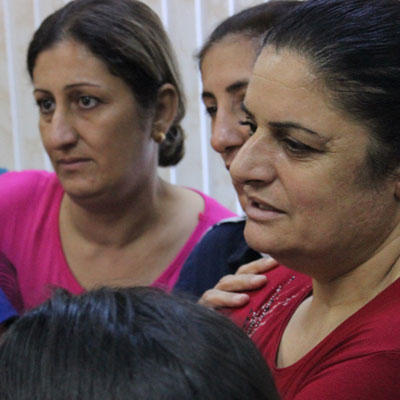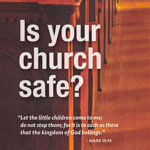How can healing come?
“Will I ever be able to find healing?” a victim asked toward the end of the session. Her tone of voice seemed to indicate she saw no hope.
Healing and restoring trust take lots of hard work. It takes a community of support — parents, partners, children, church leaders, siblings and congregations.
Healing requires personal contact: listening to stories, responding to and standing alongside the abused. We must remember that the local congregation and also the Church are secondary victims when clergy abuse.
There can be no healing without justice-making. From Faith Trust Institute come the “Elements of Justice-Making” (Clergy Misconduct: Sexual Abuse in the Ministerial Relationship). Learn more at the Faith Trust Institute
 Truth-telling
Truth-telling
Give voice to the reality of the abuse.- Acknowledging the violation
Hear the truth, name the abuse and condemn it as wrong. - Compasssion
Listen to and empathize with the victim. - Protecting the vulnerable
Take steps to prevent further abuse to the victim and others. - Accountability
The abuser is confronted and negative consequences are imposed; this step makes repentance possible. - Restitution
Make symbolic restitution of what was lost; give a tangible means to acknowledge the wrongfulness of the abuse and the harm done and to bring about healing (e.g., payment for therapy). - Vindication
To aid the process of setting the victim free from the pain caused by the abuse
Perfect justice is achieved when all seven of the elements are met. It is rare for the church to achieve perfect justice in the face of injustice. Any institution, including the church, can only do the best it knows. And that best may be approximate justice.
Healing is not an end. It is a process. Healing works on many levels and takes many forms. Healing has many voices and no single “answer.” Healing is painful, but it is more painful to turn away from the healing. My journey has been mine alone. No one else has felt the same pain or process that I have — though we “group” with others for comfort. We gather strength in knowing that we are not alone. In fact, we are never alone. My “journey” has taken me down a very special and unique path of healing and my spiritual life has grown and developed along the way. — A survivor
“When those who are directly abused and those who are secondary victims can meet in fellowship and honest dialogue, the circle of support widens for all those whose lives have been impacted. Then all can be transformed from victims to survivors to thrivers and trust can be rebuilt.” —ICI final report, p. 107
“In the face of harm perpetrated by a representative of the church, it is incumbent upon the church to do its best to do the works of justice and mercy, that is, to approximate them. Approximate justice is a realistic expectation to have of the church. It is the best means we have to heal the wounds deeply. Victims deserve more, but should at least receive approximate justice.” —Is Nothing Sacred? by Marie M. Fortune, p. 119.
Caring for the Congregation
“When Mentor Becomes Molester,” By Alexa Smith, Presbyterians Today, October 2000.
While congregations are caring for those who have been affected by clergy sexual misconduct, they need to remember they are also victims.
“Congregations need to deal with their own feelings of betrayal and anger, hurt, loss of trust and the relationship of what the minister did to their own faith,” says Peg True, co-chair of the National Capital Presbytery’s response team. “They need to talk about the misconduct — not about who did what to whom, but what this did to them as a congregation — instead of trying to bury it and make it a secret. And the temptation is to move to forgiveness too quickly, and not take the time to work through the implications of what happened.”
It is not easy to deal with this problem. But that is exactly what needs to be done, while confidentiality is respected in regard to the victims — including the members of the victim’s family and of the pastor’s family — and the pastor.
True recommends that the congregation:
- Honor the need for confidentiality, so victims do not feel the pressure to go public unless they want to
- Not blame the victim or victims
- Try to understand, both intellectually and emotionally, what happened in their church so that they may understand why the victim filed a complaint
- In case of clergy sexual misconduct, purchase insurance to cover the costs of short-term counseling for those who have been injured
Marie Fortune of the Faith Trust Institute in Seattle, Washington, (an organization that has taken the lead in addressing preventing and recovering from clergy sexual misconduct), says congregations simply need to talk about the possibility of misconduct before it ever occurs. “They need to put policies and procedures into place,” she says. Strong emotions can be managed better when there are clear guidelines to follow.
Healing Services
A healing service should be a safe place for those who have been the victims of abuse. An atmosphere of affirmation and trust is essential and care should be taken to insure that the setting is both comfortable and private. This experience can be a time to pause, reflect and care for each other. The participants will be at different junctures on their journey toward healing — some may feel that their journey is nearing completion; some may feel that they are just beginning; and others will be somewhere in between. It is a good idea to ask the participants for input regarding the elements of the service.
Help for rebuilding trust
Part of our work and witness as people of faith is to lead our culture into the most relevant, critical, and courageous conversations. Overcoming our fear and discomfort for the sake of God’s beloved people and the well-being of all is something Presbyterians understand. We want to be known as those who open up spaces for healing, peace, and reconciliation in cultures of violence, including our own.
Take and Make Holy — Honoring the Sacred in the Healing Journey of Abuse Survivors. By Marie West Zinnerman. Liturgy Training Publications, Chicago, IL 1995.
Forgiveness and Abuse: Jewish and Christian Reflections. Edited by Marie Fortune and Joretta Marshall. The Haworth Press, Inc. 2002 (pp. 71-85).
FutureChurch — A Liturgy of Lament for the Broken Body of Christ. This liturgy was developed in response to a survivor of clergy sexual abuse who asked FutureChurch to sponsor a healing service for victims. The liturgy was used in a service that was held in Cleveland on October 14, 2002, and involved 22 co-participants from northeastern Ohio. The liturgy includes music and prayer written by a Cleveland survivor of sexual abuse who is also a musician. The complete liturgy is provided in PDF format for download. It includes a detailed planning guide, diagrams of stations that were set up in the worship space, a participants’ booklet, the message that was preached and original music composed specifically for this service.
Recovering from Un-Natural Disasters is a must-read handbook for pastors and church leaders of communities who could or perhaps already have experienced an un- natural disaster, such as gun violence, suicides, or sexual abuse. Written by Laurie Kraus, David Holyan, and Bruce Wismer. Published by Westminster John Knox Press. Order here.
